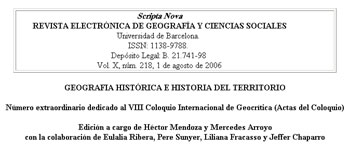Xochimilco not as an archetype. The history of an accelerated urban integration in Mexico City during the 20th century
Keywords:
Xochimilco-Mexico City, Distrito Federal-Mexico City, History of urbanization, 1900-2004, water, urban governmentAbstract
The urbanization of Xochimilco reached a turning point in the destruction of a geographic conditions of this area of the Valley of Mexico in the 20th century. The urban incorporation and conurbation were critical events whose causes are functional in origin, like an area with plenty of water for the metropolis. The territorial integration was a late process that induced a chaotic urbanization. The paper analyses this urban integration focusing on the characteristics of the urbanization in a rural and lacustrine space; the failure of political decision makers and their political rationality; the problems between the urban reality and the governmental programs, and some issues about environmental impact of the urbanization process and the desiccation of the lake and water spring and the drain of canals. Thus the conservation programs of this ecosystem could not be successful. Instead, Xochimilco could loose the ancestral rural and lacustrine conditions, in other words, its historical archetype.Downloads
Published
2007-05-03
Issue
Section
Articles
License
Los autores que publican en esta revista están de acuerdo con los siguientes términos:
- Los autores conservan los derechos de autoría y otorgan a la revista el derecho de primera publicación, cin la obra disponible simultáneamente bajo una Licéncia de Atribución Compartir igual de Creative Commons que permite compartir la obra con terceros, siempre que estos reconozcan la autoría y la publicación inicial en esta revista.
- Los autores son libres de realizar acuerdos contractuales adicionales independientes para la distribución no exclusiva de la versió de la obra publicada en la revista (com por ejemplo la publicación en un repositorio institucional o en un libro), siempre que se reconozca la publicación inicial en esta revista.





